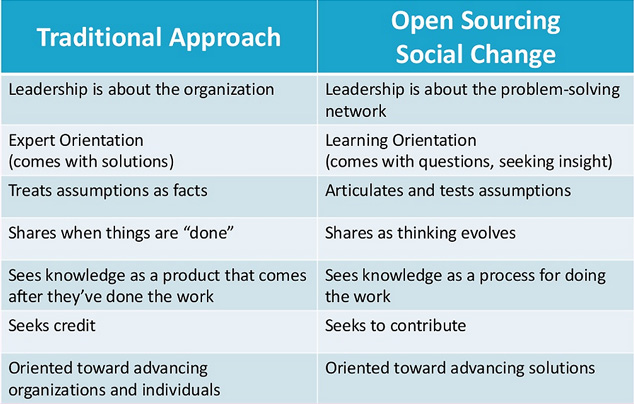Most philanthropic work for social change is focused on investing grants in organizations as the unit of getting work done. The challenge is that for many issues and places, multiple foundations and/or government are investing in organizations pursuing disconnected initiatives, leading to silos that don’t talk to each other and competing organizations working in the same space unaware of each other’s work. With competition for funding and each foundation seeking to make its mark, this sets up a dynamic that works against open sharing of information and learning about what works and what has failed.
As the rise of interest in “collective impact” demonstrates, we need ways of working at a system and/or community level that enable and encourage all players in a system to align their work, learn together, self-organize, and evolve ever more effective solutions and strategies to shift systems to healthier outcomes. We can design how we approach change like an ecosystem, with regular flow of information and exchange among many inter-related species, continually adapting and evolving, generating greater abundance, resilience, and health.
Living Cities is an example of a philanthropic organization that is putting into practice these values of openness, collaboration, and learning. Living Cities is a collaborative of 22 foundations and financial institutions that focuses on improving lives of low-income people and the cities they live in. In this slide share talk by Alison Gold, Assistant Director of Knowledge & Impact, she describes their focus on “open sourcing social change.” In a blog, she and Nadia Owusu described the current situation this way, “What we’re seeing, by-and-large, is that the mindset of individuals, organizations, and funders in the social sector is closed, secretive, even fearful. We see an unwillingness to share what we’re learning through our work, and when we do share it, it is often so far after the fact that others don’t have the chance to learn alongside us.”
This chart illustrates how Living Cities has practiced changing this dynamic (reposted here with her permission):

Source: Open Sourcing Social Change, Alison Gold, Living Cities
Building on her framework, here are some additional thoughts:
- Leadership is about helping the network and system shift – Instead of viewing leadership from the perspective of one organization trying to drive change, leadership expands to more dimensions inside and outside the organization. Leadership is about focusing on the system we are trying to change, (e.g., ending chronic homelessness, enabling low-income students to graduate from high school) and collaborating, connecting, and sharing information and learning to help all the actors in the system work more effectively.
- Learning orientation – Instead of an expert model where the foundation and/or organization views itself as outside a system intervening to fix a problem, we recognize that we are part of a larger system and it is the system’s structure that is generating undesirable behaviors. Working with others in the system, we co-create a shared understanding of how to shift the system most effectively (i.e., hypotheses about what will create change.) Then people can take actions in ways that are aligned and synergistic. Over time, importantly, people assess and learn together about what worked and didn’t, so the whole system becomes smarter.
- Collaborative learning network – Instead of seeing work as discrete projects that are invested in for a time (e.g., like an investment portfolio,) work is structured to enable people and organizations in the system to do what they do best and collaborate and learn together within a network over longer time frames to achieve bigger goals.
- Orient to advancing the field – Instead of orienting to advancing individuals and organizations, there is a shift to focus on advancing solutions. We can also orient to focus on how to help a field or system evolve to higher levels of well being/performance. For example, consider a community of practice, where people come together to share and learn to advance their craft, e.g., for how to [pick a topic – such as farm organically, facilitate great meetings, design and build super energy-efficient houses.] People invest their time not only for personal advancement or to hone a solution, but also to contribute to helping the whole field of practice evolve to a higher state of excellence. Likewise, this orientation can be brought to how we help a community and the organizations and people within it evolve to a higher state of well being.
This brings us to ask the “clean slate question:”
If we were to design a way of funding and structuring social change work based in the values of open source/ecosystems, what would it look like?
I invite your thoughts and comments.

Such an important topic, Beth. One example of what it might “look like” is shared gifting. We are testing this approach:
http://rsfsocialfinance.org/services/donors/shared-gifting/
It really shifts the thinking and feels radical for some, but as relationships and trust and increased understanding of the “whole” evolve and deepen, it begins to feel a lot more possible – and logical.